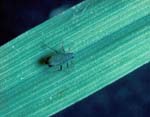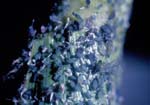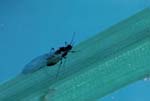Corn Leaf Aphid
Rhopalosiphum maidis
Description
The corn leaf aphid is a small bluish-green or
gray, soft-bodied, spherical insect about the size of a pinhead. The
adult females do not lay eggs, as do most other insects, but give birth
to living young. These young, called nymphs, resemble the adults except
in size. The aphids appear in clusters in the curl of the leaves and
upper part of the cornstalk and may completely cover a large area. They
are also found in appreciable numbers down in the whorl and on the
unemerged tassel. Most of the aphids in a cluster are wingless. However,
when clusters become large, females with delicate, filmy wings appear.
The wings enable them to fly to other uninfested plants and start a new
colony.
Like other insects, aphids, shed their skins in the process
of growing. These numerous white to gray skins give the appearance of a
white mold or ash. They also secrete a sticky, sugary substance known as
honeydew. Moderately to heavily infested plants are usually quite
sticky from accumulations of the honeydew.

Figure 1. Corn Leaf Aphid
Life History
Leaf aphids do not usually appear in Illinois
until late June or early July. It is not known whether they overwinter
in Illinois or whether they migrate from the southern states each year.
It is feasible to assume, however, that some of them ovexwinter on grain
crops in the southern one-third of Illinois. True egg-laying females
have never been observed. Males have seldom been observed. In general,
the time required for one generation is short. Under Illinois
conditions, there are nine generations each year. Most clusters of corn
leaf aphids include nymphs, adult wingless females, and adult winged
females at the same time.
Damage
The corn leaf aphid prefers sorghum as a host
plant, but will feed on corn, barley, broom corn, millet, sudan grass,
and many other plants belonging to the grass family. Heavily infested
corn leaves may wilt, curl, and show yellow patches. Tassels and silks
may be covered with honeydew, which may interfere with pollination.
There is no conclusive evidence that leaf aphids cause barren stalks,
but there is circumstantial evidence that barrenness occurs in about 40
percent of the heavily infested cornstalks.
Damage is most severe between the late-whorl and pollination stages. Aphids feeding at those times is suspected as the cause of stunting (shortening of the inter-nodes), shriveled and shrunken ears, and possibly barrenness. After pollination, the major damage caused by aphids is competition with the plants for available moisture.
Scouting Procedure
Corn leaf aphids are found in the whorl
of younger plants and later on the tassel and upper leaves. To monitor
aphid populations, examine 100 plants (5 sets of 20) for corn leaf
aphids during the whorl stage (3 weeks prior to tassel emergence). Rate
the infestation for each plant using the following system:
0 - No aphids
1 - 1 to 100 aphids per plant
2 - More than 100 aphids

Figure 2. Corn Infested with
Corn Leaf Aphids
Threshold Guide
Low numbers of aphids found prior to
tassel emergence are just as imporant as larger numbers found later
since aphid populations can increase rapidly. Often one or more adults
will be found with many young aphids in the protected tassel. Aphid
predators, parasites or diseases often alleviate any need for chemical
control. Look carefully and note the number and kind of predators on
those plants that have aphids. These often include lady beetles (adults
and larvae), insidious plant bugs, aphidlions and lavewing adults and
syrphid fly maggots. The aphid colonies may also contain discolored
brown or gold aphids These are diseased or ones that have been
parasitized. If 50 percent of the plants have more than 100 aphids per
plant and plants are under drought stress, treatment may be justified.
Control is also warranted if 3 percent or more of the plants have their
tassels and upper leaves heavily infested, plants are under moisture
stress, and the population is increasing. The presence of numerous
predators and parasites suggests that natural controls may be reducing
the number of aphids.

Figure 3. Winged Corn
Leaf Aphid
Control
Aphids are parasitized by some species of wasps
and are also susceptible to a fungus disease. Brown swollen aphids,
abnormally larger than other aphids in the colony, indicate parasitism.
Brown aphids with the bodies collapsed and a moldy appearance indicate a
fungus disease. Lady beetles, syrphid fly maggots, and green lacy-wing
larvae, or aphid lions, are always abundant in a heavy aphid population.
They and several other insects prey upon aphids and help to hold
populations in check.